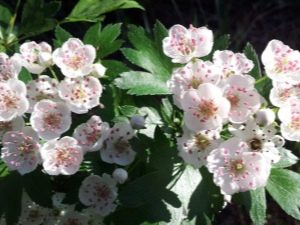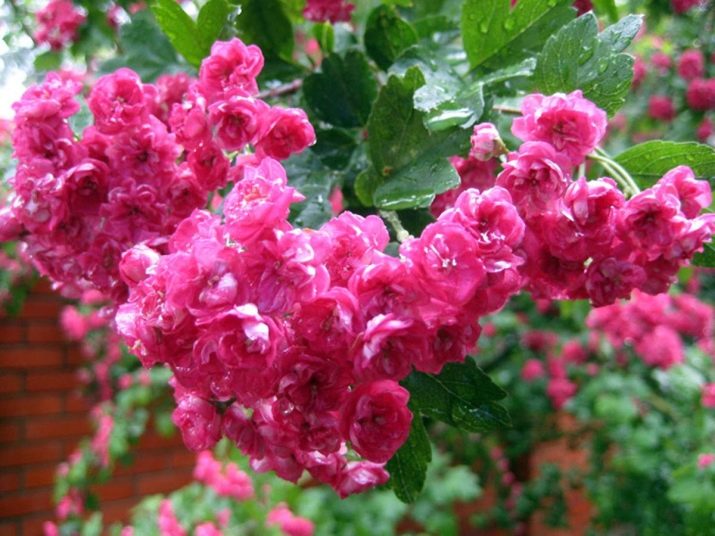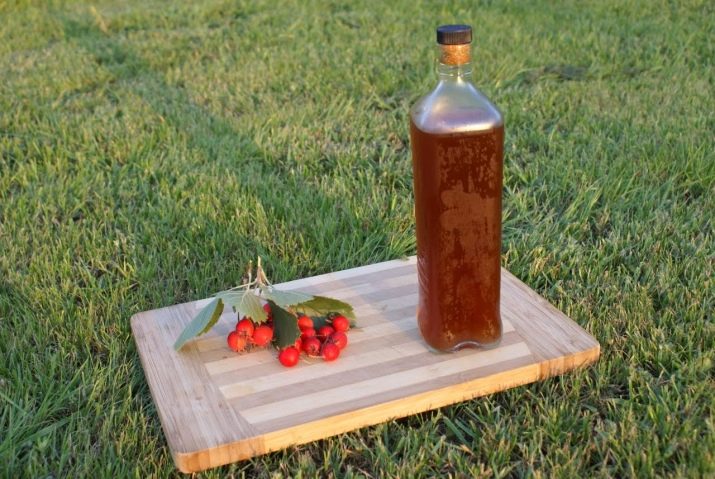Hawthorn flowers: medicinal properties and contraindications

Hawthorn is a well-known plant that has been universal for many years. Previously, such a shrub was planted in the form of a hedge, and flower beds of various sizes and shapes were formed from it, since the hawthorn is unusually beautiful during flowering. Later it turned out that the flowers of this plant can not only please the eye, but also be useful.
The positive effect of such a plant on the body revealed a long time ago, but with the development of the pharmaceutical industry, modern people forget about the popular methods of treatment. Consider the healing properties of hawthorn and contraindications for use.
Special features
From Latin, the name hawthorn translates as "strong." It got its name because of its strong part and spines.
Hawthorn blooms in late spring and early summer, abundantly and every year. The flowers are usually white, but you can also find a pale pink shade. The smell from these plants is not very pleasant (due to dimethylamine).
Hawthorn is a honey plant; its flowers are usually pollinated by flies, beetles and other insects. Self-pollination is possible, but this occurs at a time when the stamens become fully developed.
This natural medicine must be properly collected and stored. For this you need to know the following:
- The collection of flowers is carried out at the beginning of flowering (the last days of the end of May, a few days at the beginning of June). Inflorescences must be collected intact. It is necessary to put them in a container so that they do not get crushed, as the structure of the petals can be damaged, and they will quickly deteriorate.
- To dry hawthorn flowers should be immediately after collection. To create optimal conditions, it is necessary to take into account temperature and humidity. A great place where it is warm and dry - this is an attic. It is in such a well-ventilated room that the flowers will quickly dry, retaining their useful composition.
If the room is wet, then the raw material will be brown, with an unpleasant smell. It is not suitable for use.
- Inflorescences are best spread out on paper or on fabric (loose layer).
- Store medicinal raw materials must be dried: in paper bags, glass jars, cotton bags (no more than 6 months).
Ingredients: vitamins and minerals
Scientists have identified an interesting feature: the chemical composition, formula of hawthorn inflorescence is very similar to the human body. It is because of this that all the components of such a plant have been used in medicine.
Hawthorn flowers contain:
- sugar up to 10% (glucose, rhamnose, arabinose, fructose, sucrose);
- organic acids up to 1.4% (malic, tartaric, citric, crategus and others);
- vitamins (ascorbic acid to 100.7 mg per 100 g, carotene to 3.7 mg per 100 g, vitamin B1 to 0.06 mg per 100 g, vitamin B2 to 0.3 mg per 100 g, vitamin PP to 0, 56 mg per 100 g);
- bioflavonoids up to 5% (hyperoside);
- anthocyanins up to 3.6%;
- catechins 1.2%;
- coumarins up to 3.4%;
- pectic substances 6.1%;
- sorbitol to 22.5%;
- chlorogenic acids up to 300 mg / 100 g;
- trace elements per 100 g: potassium 172 mg, iron 0.6 mg, manganese 34 mg, sodium 1.2 mg;
- essential oils 15%.
Instructions for use
If you decide to use these raw materials for treatment or prophylaxis, you must first consult with your family doctor. It will help determine the presence of indications and contraindications, as well as to choose the form of the drug and the dosage.
You can make the drug yourself, and you can buy the finished product at the pharmacy. You can independently prepare juice, syrup, tincture, decoction or tea from your own billet.
It is necessary to accept means only if you do not have exacerbations of chronic diseases of a gastrointestinal tract, urinogenital or cardiovascular system.
Benefit and harm
Since each organism has its own individual characteristics, the response to hawthorn can vary. That is why this folk remedy can both benefit and harm.
Beneficial features:
- antiallergic;
- antianemic;
- decrease in blood cholesterol;
- good for insomnia;
- hypotensive property;
- anti-inflammatory effect;
- perfectly relieves psychoneurotic tension;
- antiarrhythmic;
- antisecretory;
- antibacterial;
- hypoglycemic effect.
Harm folk remedy will bring in the event that the inflorescences were collected in the period of late flowering, in bad weather conditions. Such raw materials even with proper storage will lose all their medicinal properties.
Contraindications
Please note the following:
- Children under 12 years old doctors are not advised to take hawthorn.
- Prolonged use of hawthorn beverages damages the cardiovascular system.
- The period of exacerbation of diseases of the gastrointestinal tract: esophagitis, gastritis, duodenitis, enteritis, colitis, proctitis.
- The period of exacerbation of diseases of the urogenital system: glomerulonephritis, pyelonephritis, nephritis, cystitis, urethritis.
- It is also forbidden to take this medicine hypotensive, as hawthorn has a powerful hypotensive effect.
Use during pregnancy
During pregnancy, it is allowed to use medicinal drinks from hawthorn flowers, but not alcoholic tinctures, concentrated decoctions, fresh berries.
During pregnancy, many changes occur in the body of a woman. Because of this, the immune system weakens, the nervous system suffers, much more nutrients are needed - and it is not always possible to get them from everyday food. That is why the composition of hawthorn is ideal for replenishing all minerals and vitamins. However, it is worth remembering that concentrated drinks for pregnant women are strictly prohibited.
An excellent solution to the problem of immunity and mood swings will be taking medicinal tea from hawthorn flowers. Such a drink will gradually enrich the mother's body and will not harm the fetus.
Cooking recipes
There are a lot of recipes for making healing hawthorn drinks. Created recipes that correspond to exactly one or another disease.
Bronchial asthma
The following effective methods can be distinguished:
- Recipe number 1. It is necessary to prepare a collection, which will include hawthorn flowers, limes, chamomile and elderberry. All components are mixed in a 1: 1 ratio. Such a herbal mixture will need 1 tbsp. L., which you need to pour 250 ml of boiling water. Let the mixture stand for 15 minutes. It is necessary to use such a drink for prophylaxis, 3 times a day (a few sips).
- Recipe number 2. It is necessary to mix the flowers of hawthorn, lemon balm, celandine and grass of the goose Potentilla (1: 1 ratio). In a glass of boiling water to fill 1 tbsp. l collection, he must insist about an hour. After that, the tool will need to apply 100 ml - 3 times a day.
Atherosclerosis
Get 1 tbsp. l inflorescences and 2 tbsp. l hawthorn berries, which will need to fill with 1 cup of vodka. Insist the composition is better for a week. Then you need to strain the drink and carefully squeeze the inflorescences with berries. It is necessary to use tincture on 20-30 drops (to food, 3-4 times a day).
Vegetoneuroses
One glass of boiling water pour 2 tbsp. l dry hawthorn flowers. Cover with a towel and let it stand for about 4 hours. After that, use the drink should be 2 spoons, 5 times a day.
This recipe is suitable for eliminating headache, asphyxiation, dizziness, nausea, menopause and fainting.
Diabetes
1 tbsp. l flowers and 2 tbsp. l leaves of hawthorn need to brew water (need half a liter). It should be put on a slow fire and cook for 5-7 minutes. Then you need to give the broth to infuse for several hours. Use 6 teaspoons (before meals).
Hypertonic disease
The following recipes are often used:
- Recipe number 1. It will be necessary to mix the following plants: hawthorn flowers, motherwort, horsetail grass, birch leaves, adonis grass. Pour all 1.5 liters of boiling water. Place the container in a dark place where the drink will infuse for 6 hours. After that, the liquid part needs to be decanted.Take therapeutic mixture should be 4 times a day.
- Recipe number 2. Take 1 liter of boiling water and brew motherwort grass, hawthorn flowers and berries, rosehips, dried eggs. All plants will need to take one tablespoon. Let the medium stand in a dark place (several hours will be enough). Strain the broth through a sieve. You will need to take half a glass (3 times a day).
Prostatitis
Mix flowers, leaves, hawthorn berries (2 tbsp.) With calendula flowers, black poplar buds, hazel leaves. Fill the collection with boiling water - 3 cups. Infuse such a drink should be an hour. You need to take a glass (2 times a day).
Diseases of the gastrointestinal tract
1 tsp. hawthorn flowers and 1 tsp. dry plantain fill with 1 cup of boiling water. Such a drink should be infused for 2 hours. You need to take 50 ml, 4 times a day.
People who use these recipes, leave a lot of positive feedback. That is why hawthorn is one of the most popular plants in traditional medicine.
See the next video for more on the benefits of hawthorn flowers.











































